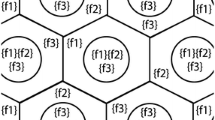Abstract
Microwave fixed links play a vital role supporting infrastructure requirements in telecommunications. As the demand for their use increases, particularly in providing backhaul for mobile networks, it is important that the microwave spectrum is exploited efficiently. This paper investigates the use of equipment selection algorithms within the microwave fixed-links frequency assignment problem. Standard data-rates are often supported by two alternative radio system types; one utilising a relatively lower-order modulation scheme and the other using relatively higher-order modulation. The higher-order modulation radios use less bandwidth to achieve the same data rate, but at the expense of higher wanted signal levels and lower interference thresholds. Hence while higher-order modulation is the more spectrally efficient option for an individual link considered in isolation, it may not be the most efficient when the wider network is taken into account. In this paper we provide a new model for the fixed link frequency assignment problem with equipment selection, formulated as an integer program, and investigate the nature of the trade-off between local and global spectral efficiency on a range of representative data.
Similar content being viewed by others
References
Flood I., Bacon D. (2006) Towards more spectrally efficient frequency assignment for microwave fixed links. International Journal of Mobile Network Design and Innovation 1(2): 147–152
European Telecommunications Standards Institute (ETSI). (2010). ETSI EN 302 217-2-2 V1.4.1, Fixed Radio Systems; Characteristics and requirements for point-to-point equipment and antennas; Part 2-2: Digital systems operating in frequency bands where frequency co-ordination is applied; Harmonized EN covering the essential requirements of Article 3.2 of the R&TTE Directive.
UK Office of Communications. (2009). OfW 446, Technical frequency assignment criteria for point-to-point radio services with digital modulation, Version 3.1.
European Radiocommunications Committee (ERC). (1991, corrected April 2005). ERC Recommendation T/R 12-01 E, Harmonized Radio Frequency Channel Arrangements for Analogue and Digital Terrestrial Fixed Systems Operating in the Band 37–39.5 GHz.
Leese R., Hurley S. (2002) Methods and algorithms for radio channel assignment. Oxford lecture series in mathematics and its applications. Oxford University Press, Oxford
Aardal K. I., Van Hoesel S. P. M., Koster A. M. C. A., Mannino C., Sassano A. (2007) Models and solution techniques for frequency assignment problems. Annals of Operations Research 153: 79–129
Allen S. M., Smith D. H., Hurley S. (1999) Lower bounding techniques for frequency assignment. Discrete Mathematics 197/198: 41–52
Montemanni R., Smith D. H., Allen S. M. (2004) An improved algorithm to determine lower bounds for the fixed spectrum frequency assignment problem. European Journal of Operational Research 156(3): 736–751
Hale W. K. (1981). New spectrum management tools. Presented at the IEEE International Symposium on Electromagnetic Compatibility, 1981.
Frazier R. A. (1975) Compatibility and the frequency selection problem. IEEE Transactions on Electromagnetic Compatibility EMC-17(4): 248–254
Flood I. (2007) Soft boundary frequency assignment methods. International Journal of Mobile Network Design and Innovation 2(3/4): 147–152
Farrar, A., & Hinkle, R. (1988). Spectrum-conservation techniques for fixed-service systems. Presented at the IEEE International Symposium on Electromagnetic Compatibility, Seattle, Aug. 2–4, 1988, Symposium Record (Cat. No.88CH2623-7), pp.252–258.
Leuenberger, K. J. (1986). Network planning aspects for terrestrial digital radio: Implications of using higher order modulation schemes. Presented at the European conference on radio-relay systems (ECRR), Munich, Nov. 4–7, 1986.
Flood, I. (2005). Spectral efficiency in mobile overlay networks. MPhil thesis, Dept. Elect. And Elec. Eng. University of Bath, UK.
European Telecommunications Standards Institute (ETSI). (2005). ETSI TR 101 854 V1.3.1, Fixed Radio Systems; point-to-point equipment; derivation of receiver interference parameters useful for planning fixed service point-to-point systems operating different equipment classes and/or capacities.
Author information
Authors and Affiliations
Corresponding author
Rights and permissions
About this article
Cite this article
Flood, I.D., Allen, S.M. The Fixed Links Frequency Assignment Problem with Equipment Selection. Wireless Pers Commun 71, 181–194 (2013). https://doi.org/10.1007/s11277-012-0810-4
Published:
Issue Date:
DOI: https://doi.org/10.1007/s11277-012-0810-4




